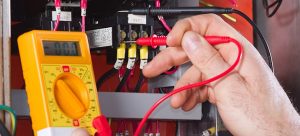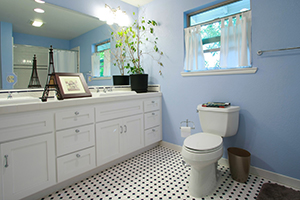
Whether your outdated electrical system has finally caught up to you, and you’re experiencing some unexplained electrical problems or whether your last amature attempt to fix that old lightswitch gave you more of a shock than you bargained for, electrical code violations can put your family at risk as well as your home. Your home’s electrical system is one of those things we easily take for granted; while it may be out of site and hidden behind your walls, it holds so much importance in just about everything we do during our day-to-day lives. When your home or businesses electrical system isn’t up to safety codes and regulations, you could not only be violating the law, but also putting your family in danger of injuries related to electric shock, and most of all, fires. Here are the top 5 electrical code violations we at United Electric find when we inspect homes.
Overcrowding Wires
Violation
During what most electrical contractors refer to as the “rough-wiring stage”, near the beginning of a new electrical installation, it can be tempting to utilize all the space you’ve been given as to save space and time. For example, you may feel like it’s a good idea to cram four or five wires through that 7/8-inch hole—this is mistake. The overcrowding of wires leads to “burning”; damage caused to a wire when it’s insulation gets torn off by another wire dragging across it. Remember that wires are delicate things. Wires are small and make it difficult to see small tears or breakages, so it’s best to avoid situations that can cause this type of damage. Leaving overcrowded wires with this type of damage due to overcrowding is an electrical safety hazard and increases risk of an electrical fire.
Solution
A good rule of thumb when you are rough-wiring is to fit no more than three wires through one 7/8-inch hole. This will leave each wire with enough room to shift and not rub against each other which reduces your risk of exposed and damaged wires. If you’ve already made the mistake of overcrowding your electrical wiring and you notice that there has been some burning, call a professional electrician to safely cut away the damaged wire, install a junction box, and replace the old wire where needed.
Knob and Tube Wiring
Violation
For hundreds of years, an old method of wiring that was commonly used was called, “knob and tube wiring”. It was considered a state-of-the-art electrical technology. Today, however, knob and tube wiring is considered very dangerous due to the wires in the system not being properly grounded; the circuits support lower amperage than is required by most homes today. The wires also feature faulty insulation which disenegrates as time passes. These systems are considered such liabilities that most insurance companies refuse to ensure homes or businesses with knob and tube wiring.
Solution
If you aren’t sure what type of electrical system your home uses, and if your home was built before 1960, you may want to consider hiring an electrician to inspect your home for knob and tube wiring. If this is the case, you should have your entire house rewired. Yes, this is costly, but what would be worse is experiencing a house fire, putting your family in danger, and not getting your insurance to cover it on top of that!
New Lights Installed onto Old Wiring
Violation
With new light fixtures demanding higher amperage and running at hotter temperatures than old wiring is used to, houses with older wiring usually require rewiring or electrical repairs at some point. Old wires used to be rated for temperatures no higher than 60 degrees Celsius while today’s lights are manufactured with wires that can get as hot as 90 degrees Celsius.
Solution
Houses with wiring that was installed before 1987 should be inspected for this specific violation. To avoid overheating of old electrical wiring due to newer, hotter light fixtures, you’ll want to have your electrician install a splice box as well as a minimum of three feet of new wiring to connect a new light fixture to old wiring. This way, you will save money and not have to rewire the entire circuit. If you aren’t sure of the age of your wiring, look for a date stamped on the insulation jacket of your wires; wires manufactured after 1987 have a date stamped on them while those manufactured before 1987 have no stamp.
Illegal Splices
Violation
While some splicing is legal, there are some restrictions that are required to safely utilize this electrical technique. A splice is a connection between two or more electrical wires. A splice must be contained inside a junction box in order to be legal as well as if the purpose for use is for temporary lighting and circuit troubleshooting.
Solution
If you need to use a splice, hire an experienced electrician near me to mount your junction box, run the wires through it and safely make a splice using the correct tools, then finally install a cover plate over the box for safety purposes.
Non-IC-Rated Recessed Lights Touching Insulation
Violation
This is a common violation, which can result in fire if not immediately corrected. Any recessed lighting that comes into direct contact with attic insulation must be IC-rated to avoid fire. If your attic insulation is not IC-rated, you must at least keep three inches of space between the insulation and the light to follow safety regulations.
Solution
This solution is the easiest to correct on your own. Check your attic’s recessed lights to be sure that they are not touching any insulation that isn’t IC-rated. If you see that this is the case, simply cut back the insulation coming in contact with your lighting and replace it with the correct insulation.
Call United Electric Today
These are just a handful of the most common electrical code violations that may occur in your home or business today. As you can see, a majority of these violations are not only illegal, but for the safety of your family. The best way to be sure that you aren’t violating even a small, unnoticeable electrical code or regulation is to count on a trained profession. The trained and insured professional electricians from United Electric have the trained eyes, experience, and tools to perform complete and comprehensive electrical inspections for homes and businesses in Southern California. When you need 24/7 electrical servicing, you can count on us. From midnight electrical emergencies, to electrical appliance installation, to routine electrical maintenance calls, United Electric will help to keep your family safe and sound and of course—never in the dark!





